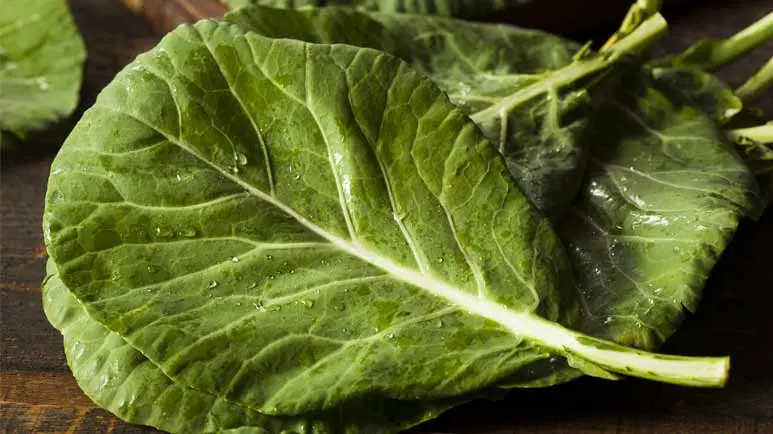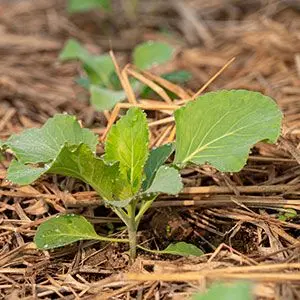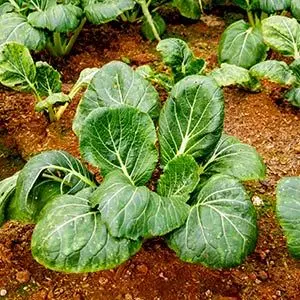Collards: Why This Mystery Food Has Pet Owners Talking
With a rich history and renowned for its assorted nutrients, this veggie may support your pet's health when served in small quantities.

STORY AT-A-GLANCE
- Collards are a cruciferous vegetable that contains sulforaphane; sulforaphane may support your pet’s health by lowering the risk of cancer, among other benefits
- Collards also contain antioxidants such as lutein and zeaxanthin, which may promote healthy vision
- Other nutrients in collards, such as vitamins A and K and calcium, may provide benefits as well
- The dietary fiber in collards may help improve your pet’s gut microbiome as well as provide roughage
- Note that collards contain oxalates, which can affect some breeds with a predisposition to oxalate urinary issues. Boil the leaves to reduce their oxalate content before serving them to your pet
Editor's Note: This article is a reprint. It was originally published February 19, 2023.
Collards (Brassica oleracea var. viridis), also called collard greens, are a staple of Southern cooking. However, their reputation is not just limited to this geographical location. They’re relished throughout the world and used in various ways — the only limit is your creativity. Used as a wrap or eaten as a simple side dish, the humble collard will find a way to satisfy you.
At the same time, you may be wondering if this leafy green may be given to your pet as well. The answer is yes, as the same nutrients that make collards healthy for humans may provide the same benefits to your pet. However, there are some caveats you need to consider first.
Sulforaphane Is the Main Bioactive Compound in Collards
Cruciferous vegetables, such as collards, have garnered a reputation for being nutritious among humans thanks to a unique bioactive compound called sulforaphane. Aside from collards, popular members of the cruciferous family include Brussels sprouts, watercress, arugula, broccoli, cauliflower and kale.1
Not only does sulforaphane benefit humans, it may benefit your beloved pet as well. According to a study published in Veterinary Medicine and Science, sulforaphane may have use in chemoprevention thanks to its free radical-scavenging properties.2 In addition, sulforaphane activates the Nrf2 protein in your pet’s body. This particular protein stimulates over 200 genes, triggering different beneficial reactions, such as managing inflammation, producing natural antioxidant protection and eliminating toxins from the body, including harmful heavy metals, mycotoxins and AGEs.3
Did You Know?

Collards are one of the oldest known vegetables, with records indicating they originated in the Mediterranean area.4
Collards Offer Antioxidants for Eye Health
Collards contain antioxidants that may help protect eye health and reduce the risk for eye disorders. A single teaspoon contains 32.5 micrograms of lutein and zeaxanthin,5 which may help mitigate light damage and protect the retina and lens from oxidative stress, reducing the risk of eye conditions such as cataracts and age-related macular degeneration.6
Household pets may reap the same benefits of lutein and zeaxanthin as well. In a study published in the Journal of Nutritional Science, beagles that were given lutein and zeaxanthin had improvements in retinal function, as well as lower decline of refractive errors.7
Other Nutrients Your Pet Can Reap from Collards
A single teaspoon of collard leaves provides your pet with the following nutrients:8
- Beta-carotene (22.5 micrograms) — This powerful antioxidant is a precursor of vitamin A,9 an important nutrient for proper bone growth, reproduction, immune response and eyesight in animals.10
- Vitamin K (3.27 micrograms) — This vitamin is necessary for blood clotting and helping reduce the risk of osteoporosis.11,12
- Calcium (5.58 milligrams) — Collards happen to be one of the top vegetable sources of calcium, according to certified nutritionist Daisy Whitbread.13 Aside from helping support bone strength, calcium plays a role in blood vessel function, muscular contraction, hormone regulation and nerve transmission.14
Collards are also a good source of fiber, providing 30 milligrams (mg) per 1-teaspoon serving.15 They’re particularly high in insoluble fiber,16 which may help improve your pet’s gut microbiome and provide roughage for optimal bowel health.17 Cats and dogs need only a small amount of fiber in their diets, and this can be achieved if you feed them a nutritionally balanced, species-appropriate meal that includes low-glycemic vegetables like collards.
Is Growing Collards Sustainable?
Collards are steadily becoming popular among Americans. According to a report from the U.S. Department of Agriculture Economic Research Service, the popularity of this vegetable has increased since they started tracking data in 2011. The annual availability of collard greens increased by 43% between 2011 and 2020, from 0.88 pounds to 1.26 pounds per capita. The top instances when collard greens are purchased are Thanksgiving, Christmas and New Year’s Day.18
While the popularity of collards is deserved because of their nutritional profile, they happen to be one of the most pesticide-ridden vegetables. According to the Environmental Working Group, collards rank third in their Dirty Dozen, which is a list of produce found to have the highest levels of pesticide residue.19 This means conventionally grown varieties found in grocery stores may contain higher amounts of toxic pesticides, which may affect your and your pet’s health.
For this reason, select organic, spray-free collard greens from your local farmers market, whenever possible. A report from Heal Label noted that sustainable growth of collard greens is not damaging to the environment. The vegetable has a low water and carbon footprint.20
Top Producers of Collards

In the U.S., the bulk of collards come from the southern states. South Carolina is the top producer.21

Antinutrients in Collards
Misinformation about many healthy fruits, vegetables, nuts and seeds abounds on the internet. This is because websites have labeled all risks (such as the risk of overconsumption causing gastrointestinal issues, or choking on too large of pieces or pits) as "toxicities," which isn't true but has managed to confuse millions of pet lovers, nonetheless.
When it comes to collards, they’re neither toxic nor poisonous to pets, but you may have heard that they contain antinutrients. These are substances found in many vegetables that act as the plants’ defense mechanism. However, in humans and animals these substances can interfere with the absorption of vital nutrients. Collards are particularly high in oxalates, containing 10 mg in one cup.22
Don’t let this scare you away from giving collards to your pet, however, because you can reduce their antinutrient content by simply cooking them. Boiling can drastically reduce oxalate levels, according to a study published in the Journal of Agricultural and Food Chemistry.23 Cooked collards can add diversity to your pet’s nutritionally complete, species-appropriate meals. You can also use them as a meal topper or ingredient in homemade treats.
Remember: Healthy treats, including collards, should only comprise less than 10% of your pet’s daily caloric intake. If your pet is prone to developing urinary oxalate stones, it’s best to restrict the use of vegetables with high oxalate content to less than 2% of your homemade recipe ingredients, rotate recipes with low oxalate content and use low-oxalate foods as treats.
Collards Fun Fact

Collard is a word derived from the Anglo-Saxon term “colewort,” which means wild cabbage or cabbage plant.24
Selecting Collards for Your Pet
Collards are available throughout the year, so selecting the freshest harvest every time you go grocery shopping is paramount. Choose collard leaves that are dark green instead of yellowed ones. Avoid brown, spotted, wilted and/or slimy leaves.25 Before feeding collards to your pet, here are three more considerations:26
- Avoid canned collards — Canned collards contain ingredients, seasonings and preservatives that may be harmful to your pet.
- Moderate the serving sizes — While leafy greens like collards are good add-ins to your pet’s meals, remember that the bulk of their diet must still come from lean meats and healthy fats. Another reason to control the serving size is because too much fiber may cause stomach upset in your pet.
- Remove raw stems — The raw stems of collards are tough and can be a choking hazard, so remove them before cooking and serving the leaves to your pet.
Once you have selected your collard leaves, prepare them with these three steps:27
- Wash the collard greens, then remove the stems by slicing along either side of the stem with a knife.
- Stack the sliced leaves in a single pile and cut crosswise.
- Boil a large pot of water and let the leaves simmer for 15 minutes, then drain.
Sources and References
- 1 NutritionFacts.org, Collard Greens
- 2 Veterinary and Comparative Oncology, September 2017, Volume 15, Issue 3, 718-730, Abstract
- 3 American Journal of Pharmacology and Toxicology 3(1):152-159, March 2008
- 4 Savannah Walking Tours, What Is the History of Collard Greens? (Archived)
- 5,8,15 USDA, Collards, Raw
- 6,7 J Nutr Sci. 2016 May 10;5:e18, Abstract
- 9,11 Journal of Food Quality 2017(9):1-8
- 10 Br J Nutr. 2012 Mar 1;108(10):1800–1809, Abstract
- 12 Total Health Magazine, Vitamin K For Pets (Archived)
- 13 My Food Data, November 10, 2024
- 14 NIH Office of Dietary Supplements, September 14, 2023
- 16 Weekand, December 27, 2018
- 17 Food Sci Nutr. 2022 Aug 26;10(10):3203-3218
- 18 USDA Economic Research Service, January 13, 2022
- 19 EWG, 2024 Shopper’s Guide to Pesticides in Produce
- 20 HEALabel, January 1, 2023
- 21,24 Food Source Information, Collard Greens (Archived)
- 22 UCI Urology Kidney Stone Center, Oxalate Content of Foods
- 23 J Agric Food Chem. 2005 Apr 20;53(8):3027-30
- 25 Michigan State University, MSU Extension Food & Health, November 19, 2021
- 26,27 MasterClass, April 15, 2022











